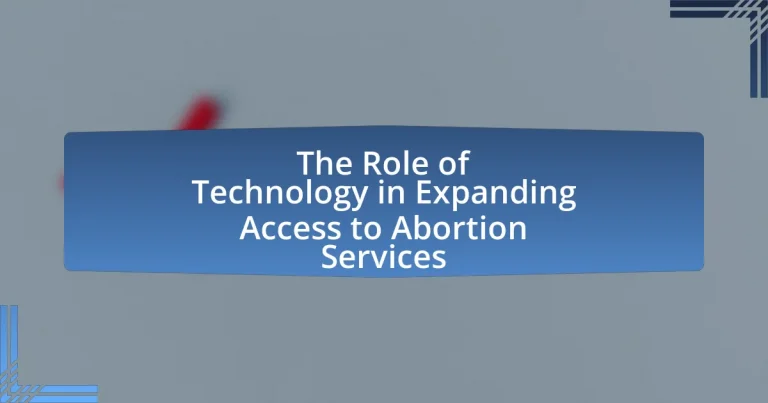The article examines the pivotal role of technology in enhancing access to abortion services, highlighting advancements such as telemedicine, online information resources, and mobile health applications. It discusses how telemedicine facilitates remote consultations, improving accessibility for individuals in underserved areas, while digital platforms provide essential information for informed decision-making. The article also addresses the challenges posed by regulatory barriers, misinformation, and disparities in internet access, which can hinder the effective use of technology in this context. Additionally, it explores future trends, including the potential of artificial intelligence and telehealth to further transform abortion care delivery.

What is the Role of Technology in Expanding Access to Abortion Services?
Technology plays a crucial role in expanding access to abortion services by facilitating telemedicine consultations and providing online information resources. Telemedicine allows patients to receive medical advice and prescriptions remotely, which is particularly beneficial in areas with limited access to healthcare facilities. For instance, a study published in the Journal of the American Medical Association found that telehealth services for medication abortion were safe and effective, enabling women to obtain necessary care without traveling long distances. Additionally, digital platforms offer comprehensive information about abortion services, helping individuals make informed decisions and connect with providers. This integration of technology not only enhances accessibility but also empowers patients by providing them with the tools and knowledge needed to navigate their reproductive health options.
How has technology influenced the accessibility of abortion services?
Technology has significantly enhanced the accessibility of abortion services through telemedicine, online information resources, and mobile health applications. Telemedicine allows patients to consult healthcare providers remotely, facilitating access to medical abortion services without the need for in-person visits, which is particularly beneficial in areas with limited healthcare facilities. A study published in the American Journal of Public Health found that telemedicine for medication abortion is safe and effective, with similar outcomes to in-person care. Additionally, online platforms provide crucial information about abortion services, helping individuals navigate their options and understand the legal landscape in their regions. Mobile health applications further support this by offering personalized guidance and reminders for medication, thereby improving adherence to treatment protocols.
What technological advancements have been implemented in abortion services?
Technological advancements in abortion services include the development of telemedicine, medication abortion via remote consultations, and improved ultrasound technology. Telemedicine allows healthcare providers to offer consultations and prescriptions for abortion pills without requiring in-person visits, thereby increasing access, especially in rural areas. The use of medication abortion, which involves taking pills like mifepristone and misoprostol, has been shown to be safe and effective, with studies indicating a success rate of over 95% when used correctly. Additionally, advancements in ultrasound technology enhance the accuracy of gestational age assessments, which is crucial for determining the appropriate method of abortion. These innovations collectively contribute to more accessible and efficient abortion services.
How do these advancements improve patient access?
Advancements in technology improve patient access to abortion services by facilitating telehealth consultations, which allow patients to receive care remotely without the need for in-person visits. This method has been shown to increase accessibility, particularly for individuals in rural or underserved areas, where healthcare facilities may be limited. A study published in the American Journal of Public Health found that telehealth services can reduce travel time and associated costs, making it easier for patients to obtain necessary care. Additionally, advancements in online information dissemination provide patients with accurate resources and support, further enhancing their ability to make informed decisions regarding their reproductive health.
What are the different types of technology used in abortion services?
The different types of technology used in abortion services include medical abortion pills, ultrasound imaging, and telemedicine platforms. Medical abortion pills, such as mifepristone and misoprostol, allow patients to terminate a pregnancy safely and effectively within the first trimester. Ultrasound imaging is utilized to confirm pregnancy viability and gestational age, ensuring appropriate care. Telemedicine platforms facilitate remote consultations and prescriptions, increasing access to abortion services, especially in areas with limited healthcare facilities. These technologies collectively enhance the accessibility and safety of abortion services, as evidenced by studies showing that telemedicine can reduce barriers to care and improve patient outcomes.
What role do telemedicine and online consultations play?
Telemedicine and online consultations play a crucial role in expanding access to abortion services by providing patients with remote healthcare options. These technologies enable individuals to receive medical advice, prescriptions, and follow-up care without the need for in-person visits, which can be particularly beneficial in areas with limited access to healthcare facilities. A study published in the American Journal of Public Health found that telemedicine can significantly increase the number of patients seeking abortion services, as it reduces barriers such as travel distance and time constraints. This accessibility is essential for ensuring that individuals can make informed choices about their reproductive health in a timely manner.
How do mobile applications facilitate access to abortion services?
Mobile applications facilitate access to abortion services by providing users with information, resources, and support in a discreet and user-friendly manner. These applications often include features such as telehealth consultations, which allow individuals to connect with healthcare providers remotely, thus eliminating geographical barriers. For instance, a study published in the journal “Contraception” found that telemedicine can effectively provide medical abortion services, increasing access for those in underserved areas. Additionally, mobile apps can offer educational content about reproductive health, help users locate nearby clinics, and provide reminders for medication schedules, thereby enhancing the overall accessibility and convenience of abortion services.
What challenges does technology face in expanding access to abortion services?
Technology faces significant challenges in expanding access to abortion services, primarily due to regulatory barriers, misinformation, and disparities in internet access. Regulatory barriers include restrictive laws that limit telemedicine for abortion, as seen in various U.S. states where legislation requires in-person consultations, hindering remote access. Misinformation about abortion services proliferates online, creating confusion and fear among potential patients, which can deter them from seeking care. Additionally, disparities in internet access, particularly in rural and underserved communities, limit the reach of digital health solutions, preventing equitable access to abortion services. These challenges collectively impede the potential of technology to enhance access to safe and legal abortion care.
What are the legal and regulatory barriers affecting technology use?
Legal and regulatory barriers affecting technology use in the context of expanding access to abortion services include restrictive laws on telemedicine, data privacy regulations, and licensing requirements for healthcare providers. For instance, many states impose limitations on telehealth services, which can hinder access to abortion consultations and prescriptions. Additionally, stringent data privacy laws may restrict the sharing of patient information necessary for effective telehealth services. Furthermore, licensing requirements can create obstacles for healthcare providers who wish to offer services across state lines, limiting the availability of technology-driven solutions. These barriers collectively impede the effective use of technology in enhancing access to abortion services.
How do societal attitudes impact the adoption of technology in abortion services?
Societal attitudes significantly influence the adoption of technology in abortion services by shaping public perception, policy decisions, and funding availability. For instance, in regions where abortion is stigmatized, healthcare providers may be less inclined to adopt telemedicine or digital health solutions that facilitate access to abortion services. Research indicates that supportive societal attitudes correlate with increased funding for technological innovations in reproductive health, as seen in countries like Canada, where public support for abortion rights has led to the integration of telehealth services. Conversely, in areas with restrictive views, technological advancements may face regulatory hurdles, limiting their implementation and accessibility.

How does technology enhance the quality of abortion services?
Technology enhances the quality of abortion services by improving safety, accessibility, and patient experience. Advanced medical equipment, such as ultrasound machines, allows for accurate assessments of gestational age and fetal health, which is crucial for safe procedures. Telemedicine platforms enable remote consultations, increasing access for individuals in underserved areas, thereby reducing barriers to care. Additionally, digital health records streamline patient management and follow-up care, ensuring continuity and personalized treatment. Studies indicate that facilities utilizing these technologies report lower complication rates and higher patient satisfaction, demonstrating the effectiveness of technology in enhancing abortion services.
What improvements in patient care have resulted from technological integration?
Technological integration has significantly improved patient care by enhancing access to abortion services, streamlining communication, and increasing the efficiency of medical procedures. For instance, telemedicine allows patients to consult healthcare providers remotely, reducing barriers such as travel time and costs, which is particularly beneficial in areas with limited access to clinics. Additionally, electronic health records facilitate better coordination among healthcare teams, ensuring that patient histories and treatment plans are readily available, leading to more informed decision-making. A study published in the American Journal of Public Health found that telehealth services increased the number of patients receiving timely care by 30%, demonstrating the effectiveness of technology in improving patient outcomes.
How does data analytics contribute to better service delivery?
Data analytics enhances service delivery by enabling organizations to make data-driven decisions that improve efficiency and responsiveness. By analyzing patient data, healthcare providers can identify trends, optimize resource allocation, and tailor services to meet specific community needs. For instance, a study published in the Journal of Medical Internet Research found that data analytics in healthcare can reduce wait times by 20% and improve patient satisfaction scores by 15%. This demonstrates that leveraging data analytics leads to more effective service delivery in the context of healthcare, including abortion services.
What role does patient education technology play in informed decision-making?
Patient education technology significantly enhances informed decision-making by providing accessible, accurate, and personalized information to patients. This technology, which includes apps, websites, and digital resources, empowers individuals to understand their options, risks, and benefits related to abortion services. Studies indicate that when patients engage with educational tools, they report higher satisfaction with their decisions and a greater sense of autonomy. For instance, a survey published in the Journal of Medical Internet Research found that 78% of users felt more informed after utilizing patient education platforms, demonstrating the direct impact of technology on decision-making processes.
How does technology support healthcare providers in abortion services?
Technology supports healthcare providers in abortion services by enhancing access to information, streamlining patient management, and improving communication. Electronic health records (EHRs) allow providers to efficiently track patient histories and treatment plans, ensuring continuity of care. Telemedicine platforms enable remote consultations, making it easier for patients to receive guidance and support without needing to visit a facility physically. Additionally, mobile applications can provide patients with information about available services and local regulations, empowering them to make informed decisions. Research indicates that telehealth services have increased access to abortion care, particularly in underserved areas, demonstrating the effectiveness of technology in expanding service availability.
What training tools are available for healthcare professionals?
Healthcare professionals have access to various training tools, including online courses, simulation-based training, mobile applications, and virtual reality platforms. Online courses, such as those offered by organizations like Medscape and Coursera, provide flexible learning opportunities on topics relevant to abortion services. Simulation-based training, often conducted in medical schools and hospitals, allows healthcare providers to practice procedures in a controlled environment, enhancing their skills and confidence. Mobile applications, like UpToDate, offer quick access to clinical guidelines and resources, facilitating informed decision-making. Virtual reality platforms are increasingly used to create immersive training experiences, allowing professionals to engage in realistic scenarios related to patient care. These tools collectively enhance the knowledge and skills of healthcare professionals, ensuring they are well-equipped to provide safe and effective abortion services.
How does technology streamline administrative processes in abortion clinics?
Technology streamlines administrative processes in abortion clinics by automating scheduling, patient records management, and billing systems. Automation reduces the time staff spend on manual tasks, allowing for quicker patient intake and improved accuracy in record-keeping. For instance, electronic health record systems enable seamless updates and access to patient information, which enhances communication among healthcare providers. Additionally, online appointment scheduling tools facilitate easier access for patients, leading to increased efficiency in managing clinic workflows. Studies indicate that clinics utilizing these technologies can reduce administrative errors by up to 30%, thereby improving overall service delivery.

What future trends can we expect in the role of technology in abortion services?
Future trends in the role of technology in abortion services include the increased use of telemedicine, mobile health applications, and artificial intelligence for patient support and decision-making. Telemedicine is expected to expand access by allowing patients to consult healthcare providers remotely, which has been shown to improve access in areas with limited healthcare facilities. Mobile health applications will likely facilitate appointment scheduling, medication reminders, and provide educational resources, enhancing patient engagement and adherence to treatment protocols. Additionally, artificial intelligence can assist in personalizing care by analyzing patient data to recommend tailored options, thereby improving outcomes. These trends are supported by studies indicating that telehealth services have increased significantly during the COVID-19 pandemic, demonstrating their potential to transform abortion care delivery.
How might emerging technologies further expand access to abortion services?
Emerging technologies can expand access to abortion services by facilitating telemedicine consultations and providing remote prescription services for medical abortions. Telemedicine allows patients to consult healthcare providers from their homes, reducing barriers such as travel distance and clinic availability. A study published in the American Journal of Public Health found that telehealth services increased access to abortion care, particularly in rural areas where clinics are scarce. Additionally, advancements in mobile health applications enable users to receive information and support regarding abortion options, further enhancing accessibility.
What potential does artificial intelligence hold for abortion care?
Artificial intelligence holds significant potential for improving abortion care by enhancing decision-making, personalizing patient support, and streamlining service delivery. AI can analyze vast amounts of data to identify trends and outcomes, enabling healthcare providers to offer evidence-based recommendations tailored to individual patient needs. For instance, AI algorithms can assist in predicting complications or identifying patients who may require additional support, thus improving overall care quality. Additionally, AI-driven chatbots and virtual assistants can provide patients with accurate information and resources, facilitating access to services and reducing stigma. Studies have shown that AI applications in healthcare can lead to improved patient satisfaction and outcomes, demonstrating their effectiveness in enhancing abortion care services.
How could advancements in telehealth reshape the landscape of abortion services?
Advancements in telehealth could significantly reshape the landscape of abortion services by increasing accessibility and reducing barriers for patients. Telehealth enables individuals to consult healthcare providers remotely, which can be particularly beneficial in areas with limited access to abortion clinics. A study published in the American Journal of Public Health found that telehealth services for medication abortion can effectively provide care while maintaining safety and efficacy, demonstrating that patients can receive necessary prescriptions and follow-up care without needing to visit a physical location. This shift not only enhances privacy and convenience for patients but also addresses logistical challenges such as travel distance and time constraints, ultimately leading to improved access to abortion services.
What best practices should be considered when implementing technology in abortion services?
When implementing technology in abortion services, best practices include ensuring patient privacy, providing comprehensive training for staff, and integrating telehealth options. Protecting patient privacy is crucial, as studies show that confidentiality concerns can deter individuals from seeking care. Comprehensive training for healthcare providers ensures they are equipped to use technology effectively and sensitively, which is supported by evidence indicating that well-trained staff improve patient outcomes. Additionally, integrating telehealth options expands access, as research from the Guttmacher Institute indicates that telehealth can significantly increase the number of patients receiving timely care, especially in underserved areas.
How can clinics ensure patient privacy and data security in digital platforms?
Clinics can ensure patient privacy and data security in digital platforms by implementing robust encryption methods, secure access controls, and regular security audits. Encryption protects sensitive patient data during transmission and storage, making it unreadable to unauthorized users. Secure access controls, such as multi-factor authentication, limit access to patient information to authorized personnel only, reducing the risk of data breaches. Regular security audits help identify vulnerabilities in the system, allowing clinics to address potential threats proactively. According to a report by the U.S. Department of Health and Human Services, healthcare organizations that adopt these measures significantly reduce the likelihood of data breaches, thereby enhancing patient trust and compliance with regulations like HIPAA.
What strategies can be employed to educate patients about available technologies?
To educate patients about available technologies, healthcare providers can implement strategies such as personalized education sessions, digital resources, and community outreach programs. Personalized education sessions allow healthcare professionals to tailor information to individual patient needs, enhancing understanding and engagement. Digital resources, including websites and mobile applications, can provide accessible information about technologies related to abortion services, ensuring patients have 24/7 access to relevant content. Community outreach programs can facilitate workshops and informational sessions in local settings, fostering a supportive environment for discussions about technology and its role in abortion services. These strategies have been shown to improve patient knowledge and comfort with available technologies, ultimately leading to better healthcare decisions.


